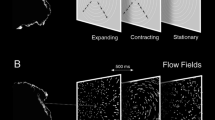Abstract.
The processing of optic flow fields in motion-sensitive areas in human visual cortex was studied with BOLD (blood oxygen level dependent) contrast in functional magnetic resonance imaging (fMRI). Subjects binocularly viewed optic flow fields in plane (monoptic) or in stereo depth (dichoptic) with various degrees of disparity and increasing radial speed. By varying the directional properties of the stimuli (expansion, spiral motion, random), we explored whether the BOLD effect reflected neuronal responses to these different forms of optic flow. The results suggest that BOLD contrast as assessed by fMRI methods reflects the neural processing of optic flow information in motion-sensitive cortical areas. Furthermore, small but replicable disparity-selective responses were found in parts of Brodmann's area 19.
Similar content being viewed by others
Author information
Authors and Affiliations
Additional information
Electronic Publication
Rights and permissions
About this article
Cite this article
Rutschmann, R., Schrauf, M. & Greenlee, M. Brain activation during dichoptic presentation of optic flow stimuli. Exp Brain Res 134, 533–537 (2000). https://doi.org/10.1007/s002210000502
Received:
Accepted:
Issue Date:
DOI: https://doi.org/10.1007/s002210000502




